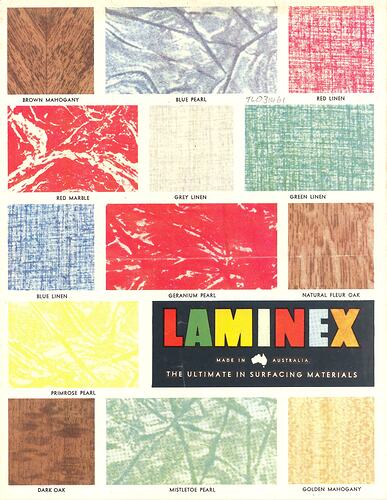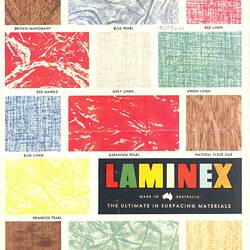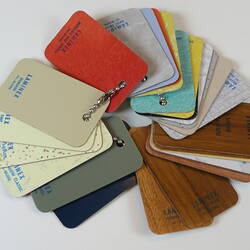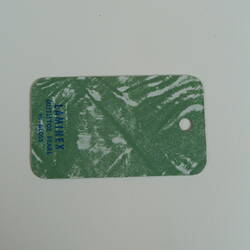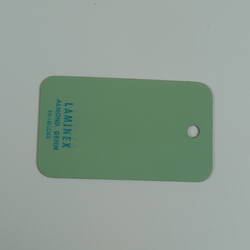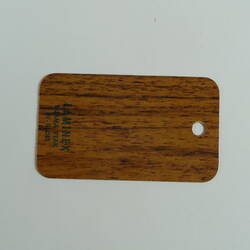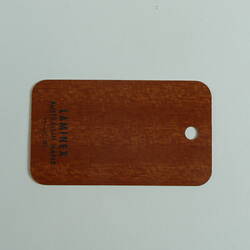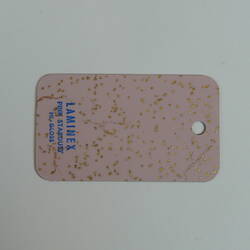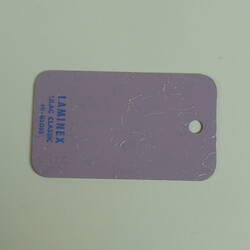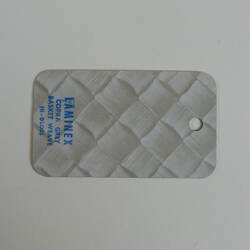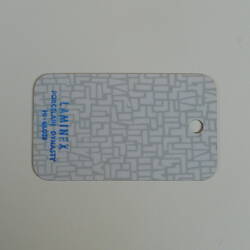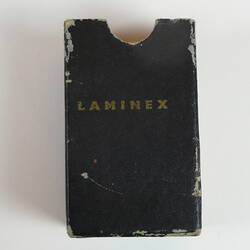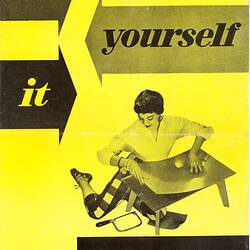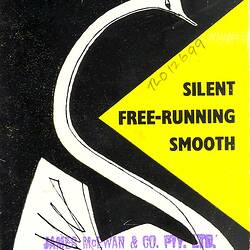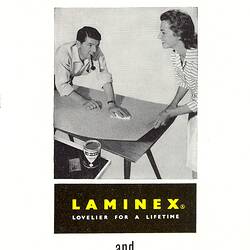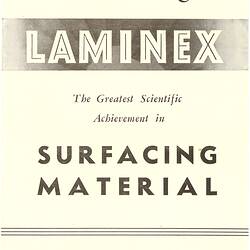Laminex Pty Ltd was one of the first companies to manufacture and distribute decorative plastic laminates within Australia. The company was established in 1934 by Robert M Sykes and his silent partner Arthur E Beck. It operated out of a tin shed with a floor size of 840 square feet in Brighton, a suburb of Melbourne. The company began making laminated resin timing, gear wheels for car engines, and later found other uses for resin sheeting, such as insulation boards and circuit boards. The production process was very simple - fabric was cut using scissors, resin was prepared in a 44 gallon drum, in which the fabric was impregnated, then the fabric was passed through a hand-operated mangle which produced the resin sheets. During World War Two the company manufactured industrial products for the defence force, and within two years business had expanded its annual sales to £75,000. The factory floor space grew to 15,00 square feet across three tin sheds. This success allowed Sykes to buy out his silent partner, Beck.
As World War Two came to an end and laminates became increasingly obsolete in the automotive and electrical industries, Sykes turned his attention to new products - the use of laminates in household furniture and decoration. In 1946 Sykes visited the USA to research the production of decorative laminates, and by the late 1940s the Laminex company had begun producing its first interior décor product range. This featured 'easy care' plastic sheets in an array of colours, patterns and textures for use in interior decoration.
The first Laminex plastic laminate sheets were approximately 8' x 4' feet in size and came in only one thickness of 1/16 inches. They featured a limited range of colours and designs - two or three prints in four to six colours, and were only available in a gloss finish. This early range was produced with limited equipment at the Brighton site. In 1952 Laminex moved to a new 160,000 square foot factory at 332 Bay Road, Cheltenham, where a hydraulic laminate press was installed. This allowed the expansion of laminex sheeting design and production, and during the early 1950s the colour and pattern range grew, and came to include two tone designs.
Colourways referenced popular fashions of the time, and by the 1950s included pastels such as 'Coral Pink' and 'Apple Green' which represented the 1940s palette, while strong primary colours, synonymous with the 1950s Modernist movement, were included in the range to cater for developing tastes. Patterns included wood grains, marbles, linen weaves, basket weaves and metallic threads, drawing inspiration from the South Pacific and abstracted organic designs.
Initially, Laminex products were only distributed as a wholesale building and furnishing material to furniture manufacturers and cabinet makers, who fabricated their own products with decorative laminates and sold them through show rooms and major department stores. One of the major distribution partners of the Laminex company was AV Wehl & Co Pty Ltd, originally a cabinet making business in Essendon, which expanded into laminate distribution.
During the 1950s Laminex products became accessible directly to the public, with the release of 'contact adhesive', a binding agent which enabled the handyman and do-it-yourself enthusiast to apply decorative surfaces within the home. The manufacture of particle board in the 1960s further increased the DIY appeal of Laminex products.
By 1956 the Brighton factory site had closed down, while the Cheltenham plant continued to grow. The product range continued to increase, and included a vinyl floor covering branded as 'Gerflex' and a corrugated fibreglass roofing named 'Wonderglass'. During the 1960s the company also produced 'Garnite' polythene pipes and a wide range of laminate plastics and adhesives. During the 1970s, Laminex Pty Ltd expanded into the manufacture of substrate materials, such as particleboard, made at a factory in Ballarat, and MDF, made at Wagga Wagga. Laminex established timber mills in Ballarat in 1970 and Wagga Wagga in 1982. By the late 1980s Laminex products were being exported into Asia. In the 1990s the Laminex Group acquired the Formica plant in New Zealand, and expanded their factory sites around Australia.
Laminex has been innovatively and successfully marketed during its history. In the mid 20th century Laminex products were advertised in influential Women's Magazines, such as Australian Home Beautiful and House and Garden. Full page advertisements featured marketing campaigns promoting the 'laminex . lovelier for a lifetime' trade mark, and served to reinforce the brand's functionality. Retail showrooms were also an effective marketing tool, where samples of the Laminex product were available to take home for 'colour matching'. In the 1980s the company built 'Laminex House', a domestic home extensively featuring Laminex products, in Warrandyte, a suburb of Melbourne. The house was used to market Laminex's products. In 1992 Colour Confidence Centres were introduced to assist customers in choosing complementary décor schemes for their homes. In the early 21st century more than ten million sample chips are distributed.
During the mid 20th century, production of laminex was dominated by restrictions and the rationing of building materials as a result of World War Two, however, the appeal of decorative plastic laminates grew steadily. Demand corresponded with a dramatic change in the configuration and design of domestic spaces. During the 1950s the status of the kitchen had been elevated from a skillion at the rear of the house, to the centre of the family home. Open plan living integrated the kitchen into spaces once reserved for more passive pursuits, such as formal dining. Contemporary kitchens required versatile and durable cabinetry, with surface treatments that were practical, hygienic and aesthetically pleasing. Plastic laminates introduced colour and pattern into the kitchen, providing an attractive and stimulating space in which to carry out domestic chores without diminishing the functionalism of the kitchen.
The success of Laminex Pty Ltd drew attention from other companies, and in 1958 it was acquired by Australian Consolidated Industries (ACI). Sykes remained managing director of Laminex. In 1965 ACI bought a 28% interest in their distribution company, AV Wehl. It later bought a competitor, Charles Hope & Co, who made a laminate branded as 'Panelyte'. AV Wehl bought Laminex Industries and Charles Hope & Co from ACI, but ACI subsequently bought back AV Wehl and Laminex Industries. Thus, from the 1970s-1988 ACI was the holding company for the Laminex Group. From 1988 ACI was known as BTR Nylex and was the holding company for Laminex Group until 1998. At this time CVC Capital Partners, a European company, purchased the Laminex Group. In 2002 the Laminex Group was brought by Fletcher Building Limited.
References
Cuffley, P. (1993) Australian Houses of the Forties and Fifties, Five Mile Press Pty Ltd, Rowville.
Hall, W. & Hall, D. (2007) Australian 50s 60s Décor, Tandem Publishing, Malvern.
Jackson, L. (1994) Contemporary: architecture and interiors of the 1950s, Phaidon Press Ltd, London.
McCarthy, K. (2007) 50/60/70 Iconic Australian Houses: Three Decades of Domestic Architecture, Murdock Books, Millers Point, NSW.
Formica Company History, http://americanhistory.si.edu/archives/AC0565.htm, accessed 12/08/08.
Schwartz, M. (1992) Composite Material Handbook, McGraw-Hill Inc. USA.
Timms, P. (2008) Private Lives: Australians at home since federation, Miegunyah Press, Melbourne.
The Australian Home Beautiful Magazine, July 1947, page 47.
The Australian Home Beautiful Magazine, June 1955, page 80.
The Australian Home Beautiful Magazine, August 1959, page 46.
The Australian Home Beautiful Magazine, December 1959, page 9.
The History of Plastics in Australia, Plastics and Chemicals Industries Association, http://pacia.org.au/history, accessed 12/08/08.
The Laminex Group (2005) A Colourful History, Laminex.
Authored by Kelly Wynne, Deakin University Student and Fiona Kinsey, Curator of Domestic Life, October 2008.
More Information
-
Keywords
-
Authors
-
Article types
